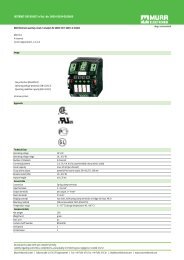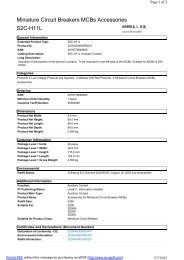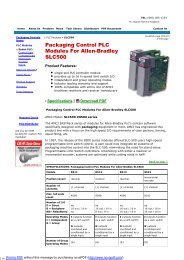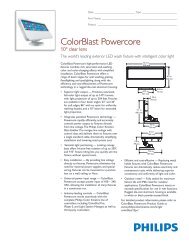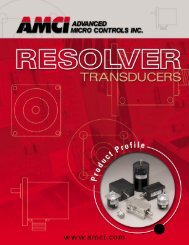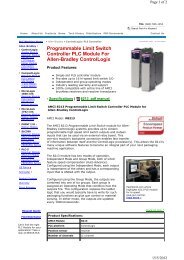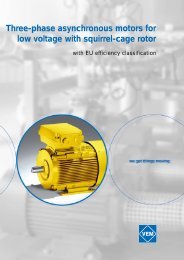for Explosive Atmosphere
for Explosive Atmosphere
for Explosive Atmosphere
- No tags were found...
You also want an ePaper? Increase the reach of your titles
YUMPU automatically turns print PDFs into web optimized ePapers that Google loves.
Installation and electric connection<br />
The erection of electrical installations in potentially explosive atmospheres requires in Germany the observance of the following regulations:<br />
- DIN VDE 0118 „Erection of Electrical Installations in Mines“.<br />
- ElBergV „Elektrobergverordnung“<br />
(Ordinance Regulating the Electrical Installations in Mines).<br />
- DIN 56 165/VDE 0165/DIN EN 60079-14 „Installation of Electrical Apparatus in Hazardous Areas.<br />
-VbF<br />
„Verordnung über brennbare Flüssigkeiten“<br />
(Ordinance Concerning Flammable Liquids)<br />
Abroad are to be followed the corresponding national regulations.<br />
The general safety and commissioning instructions are valid <strong>for</strong> the electric connection. The cable entries must be approved <strong>for</strong> the explosion-proof<br />
area and they must be protected against selfloosening. Non-used apertures are to be closed with accepted plugs.<br />
Protective measures against excessive temperature rise<br />
If the test certificate or the rating plate do not contain different data concerning duty type and tolerances, the electrical machines are designed <strong>for</strong><br />
continuous duty and <strong>for</strong> normal starts, not recuring frequently, in the course of which the temperatures are not rising essentially. The motors can only<br />
be used <strong>for</strong> that duty being indicated on the rating plate.<br />
The range A in DIN EN 60034-1 (VDE 0530, part 1) - voltage ± 5 %, frequency ± 2 %, wave<strong>for</strong>m, supply balance - is to be observed so that the temperature<br />
rises within the admissible limits. Greater deviations from the design values can cause an excessive temperature rise of the electric machine<br />
and must be indicated on the rating plate.<br />
Each machine is to be protected in all phases against excessive temperature rise by means of an inverse time-delay circuit breaker with phase-failure<br />
protection according to VDE 0660 or an equivalent device. The protective device is to be set to the design current. In case of windings in delta<br />
connection, the trip elements are connected in series with phase windings and set to 0,58 times the design current. When being impossible this<br />
connection, additional protective measures are necessary (eg. thermal machine protection).<br />
In contrast to the degree of protection „Ex-n“, in case of the „increased safety“ the start will be monitored too. There<strong>for</strong>e, in case of locked rotor, the<br />
protective device must disconnect within the t E -time indicated <strong>for</strong> the corresponding temperature class. The requirement is fulfilled if the tripping time<br />
- it is to be taken from the tripping characteristic (initial temperature of 20 °C) <strong>for</strong> the ratio I A /I N - doesn’t exceed the indicated t E -time.<br />
In compliance with the data of the certificate of con<strong>for</strong>mity, electrical machines <strong>for</strong> heavy starting (acceleration time > 1,7 x t E -time) are to be protected<br />
through a starting-cycle monitoring circuit.<br />
Thermal machine protection through direct temperature monitoring of the winding is admissible if that is certified and indicated on the rating plate. It<br />
is consisting of temperature sensors according to DIN 44081 / 44082 which in connection with tripping units, provided with the mark of con<strong>for</strong>mity<br />
of an authorized testing agency, are guaranteeing the explosion-protection.<br />
In case of pole-changing motors, seperate interlocked protective devices are necessary <strong>for</strong> each speed step. We recommend devices provided with<br />
the test report of an authorized testing agency.<br />
Maintenance and repair<br />
In Germany, maintenance, repair and modifications at explosion protected machines are to be carried out observing the ElexV/ElBergV, the safety<br />
instructions und descriptions of the general maintenance instructions.<br />
Work, influencing the explosion protection, such as eg.:<br />
- repair work at the stator or rotor winding and at the terminals,<br />
- repair work at the ventilation system,<br />
- the disassembly of explosion-proof machines,<br />
are to be carried out at the manufacturer or through a workshop specialized <strong>for</strong> electrical machines.<br />
The work is to be marked by an additional repair name plate with the following data:<br />
- date<br />
- operative firm<br />
- if necessary, mode of repair<br />
- if necessary, sign of the expert.<br />
If the work will not be realized by part of the manufacturer, it is to be accepted by an officially recognized expert who has to issue a written confirmation<br />
or to provide the machine with his mark of con<strong>for</strong>mity. Abroad are to be observed the corresponding national regulations.<br />
Spare parts<br />
There may only be used original spare parts (see list of spare parts), excepting standardized, commercial and equivalent parts (eg. antifriction bearings);<br />
in particular, this applies to seals and connecting pieces too.<br />
11




